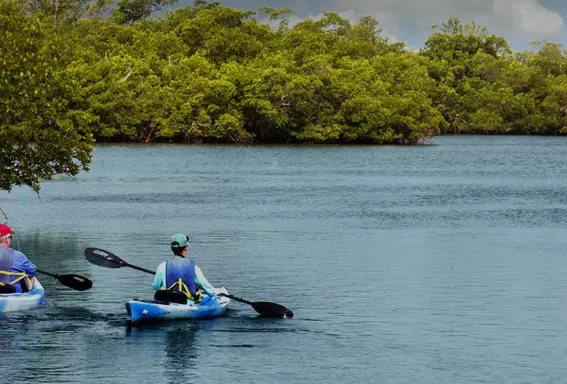Estuaries and Other Ecosystems
From mangrove islands to oyster bars to sea grass beds, each ecosystem plays a role in the estuary’s health.
This informative guide explains the different ecosystems you will see while exploring the Great Calusa Blueway Paddling Trail and the roles each one plays in the bigger natural picture.
Did You Know...
- About 40 percent of Florida's endangered and threatened species are found in the estuaries?
- About 80 percent of Florida's recreational or commercially important fish, shellfish and crustaceans spend some part of their lives in the estuaries, usually when they are young?
- Thickets of red mangroves utilize about 95 percent of available sunlight?
- Turtle grass beds produce more organic material than a cultivated food crop?
- Estuaries are among the most productive ecosystems in nature?
Mangroves
Red, black and white mangroves are vital to Florida's coast as the first stand of defense against storm surges, erosion and pollution. The mangrove forest provides nesting and nursery areas for hundreds of animals.
Red mangroves are found in and near the water at the lowest tide level and have special cell membranes in their roots to filter the salt. Their root system provides food and habitat for approximately 70 percent of area sea creatures.
Black mangroves grow slightly inland of the red. The bark is much darker than that of the other mangroves, and the tree has flat, green, bean-like seeds. Clusters of small, white, sweet-smelling flowers tip the tree's short limbs.
White mangroves are found at a higher elevation and have regular tree-like roots that are exposed. The bark is much lighter in color, and the leaves are very distinctive with rounded, thick leaves equipped with a gland to secrete salt.
Mud Flats
Leaves falling off mangrove trees all year 'round break down on the damp, rich earth. This organic detritus is consumed by small animals, which are in turn fed upon by other species, which are prey for predators higher on the food web.
When the tide comes in and covers the flats, it brings with it predators to feed on the crabs, amphipods and snails. Wading shore birds enjoy this great bounty.
Tidal Flats
Tidal flats are used by shore and wading birds as feeding and loafing areas. They may consist of exposed beaches, spoil and shoal areas and mud flats. They are very vital to crabs, oysters, clams and worms and valuable to estuaries because of the extensive growth of algae.
Sea Grasses
Sea grasses are of vital importance to the estuary as habitat, filtering system, oxygen producer and bottom stabilizer. Sea grass leaves provide protective cover for juvenile marine animals and provide food for other animals, such as the manatee. Six species of sea grasses live in Florida's estuaries.
Shoal grass grows in shallow, disturbed areas forming lush green beds with 18 inch narrow flat leaves.
Turtle grass is one of Florida's most abundant underwater grasses. The flattened leaves are thicker and wider than shoal grass leaves.
Manatee grass leaves are slender and cylindrical and reach lengths of three feet or more. As the name implies, it is a favorite food of the manatee.
Johnson's sea grass has thin elliptical leaves a few inches in length with a midvein. As a slow grower, and recovery from environmental distress is poor.
Paddle grass has paired leaves like Johnson's grass with minutely serrated margins and a shorter, broader profile.
Star grass has two to four pairs of elliptical leaves on the end of a one-and-one-half-inch stem, resembling a star.
Rookery Islands
More than a dozen species of wading and water birds make their homes and raise their young on the area's islands. In a recent survey, more than 190 nests were counted on just four rookery islands, with 16 separate species observed.
Deep-Water Areas
The shallow nature of area waters makes passes, channels, rivers and creeks critical areas for tidal flushing, which is necessary to maintain a healthy estuary. These passes allow predator fish and mammals – including hammerhead and blacktip shark, dolphin, jack crevalle, Spanish mackerel, goliath grouper and tarpon – into the bay.
Oyster Bars
Oyster bars convert plankton and detritus into animal protein (flesh), which becomes available to higher levels through predation. Oyster bars create a unique habitat space inhabited by small fish, crabs and invertebrates.
Hardwood Hammocks
Hammocks are found on fertile, well-drained soils, including shell middens and mounds. Hammocks exist because the Calusa Indians and their archaic forbears built up the ground with shell and sand. After centuries of existence, subtropical vegetation has taken over these islands.

